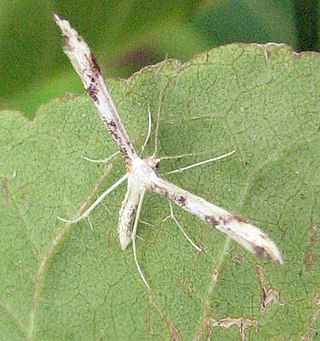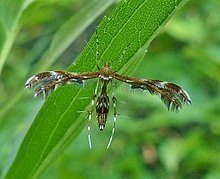Trichoptilus pygmaeus is a moth of the family Pterophoridae. It is found in North America, including California, Florida and British Columbia.

Oidaematophorus eupatorii, the eupatorium plume moth or Joe Pye plume moth, is a moth of the family Pterophoridae. It is found in North America, including Florida, Mississippi, Iowa, New York, California and Vancouver Island. It is also known from Mexico, Guatemala and Panama.
Paraplatyptilia edwardsii is a moth of the family Pterophoridae. It is found in North America.
Paraplatyptilia albidus is a moth of the family Pterophoridae. It is found in North America.
Paraplatyptilia grandis is a moth of the family Pterophoridae. It is found in North America.
Paraplatyptilia cooleyi is a moth of the family Pterophoridae. It is found in North America.
Platyptilia albicans is a moth of the family Pterophoridae. It is found in North America.
Singularia walsinghami is a moth in the family Pterophoridae and is found in North America.

Adaina montanus is a moth of the family Pterophoridae. It is found in North America, including south-eastern Canada and the north-eastern United States.
Oidaematophorus baroni is a moth of the family Pterophoridae that is found in North America.
Stenoptilia coloradensis is a moth of the family Pterophoridae. It is found in North America.
Hellinsia auster is a moth of the family Pterophoridae that is found in the U.S. state of Arizona. The species was first described by William Barnes and Arthur Ward Lindsey in 1921.
Hellinsia linus is a moth of the family Pterophoridae first described by William Barnes and Arthur Ward Lindsey in 1921. It is found in North America, including Pennsylvania, Ohio, Maryland and Massachusetts.
Hellinsia cadmus is a moth of the family Pterophoridae first described by William Barnes and Arthur Ward Lindsey in 1921. It is found in North America, including Arizona and California.
Hellinsia iobates is a moth of the family Pterophoridae that is found in the U.S. state of Arizona. The species was first described by William Barnes and Arthur Ward Lindsey in 1921.
Hellinsia cochise is a moth of the family Pterophoridae that is found in Arizona. The species was first described by William Barnes and Arthur Ward Lindsey in 1921.
Hellinsia ares is a moth of the family Pterophoridae that is endemic to the US state of Utah. The species was first described by William Barnes and Arthur Ward Lindsey in 1921.
Hellinsia varius is a moth of the family Pterophoridae that is found in the US states of California and Arizona. The species was first described by William Barnes and Arthur Ward Lindsey in 1921.
Hellinsia perditus is a moth of the family Pterophoridae first described by William Barnes and Arthur Ward Lindsey in 1921. It is found in the US states of California and Colorado.

Hellinsia arion is a moth of the family Pterophoridae that can be found in North America, including Alberta and Arizona. The species was first described by William Barnes and Arthur Ward Lindsey in 1921.



